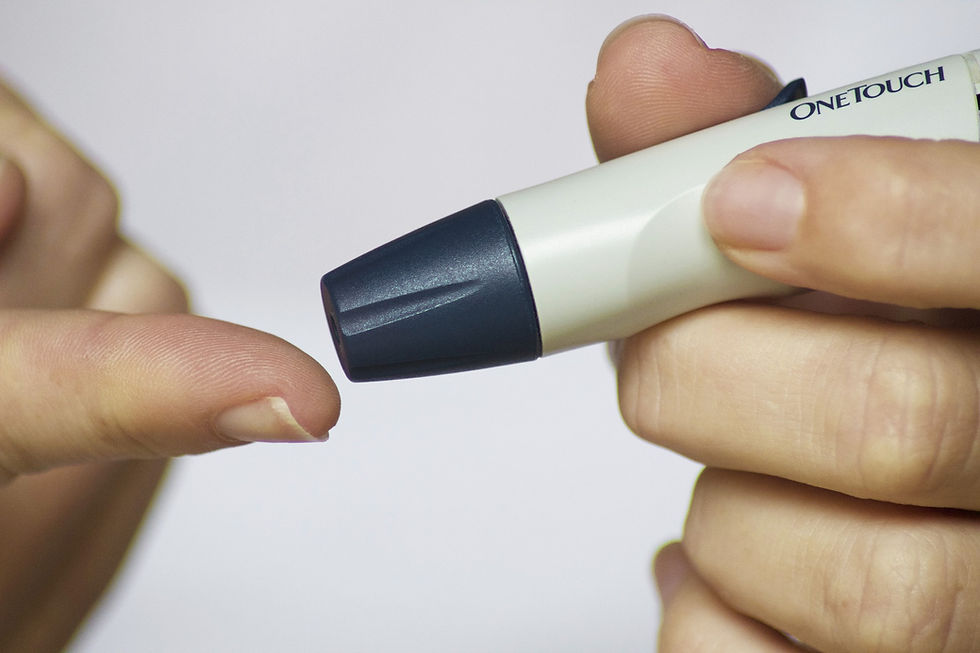How Chronic Stress Affects Glucose Metabolism: Its Role in Type 2 Diabetes, Obesity, and Metabolic Syndrome
- Tranquility Foods

- May 31
- 2 min read
Stress, Synthetic Vitamin A, and Glucose Metabolism: Understanding What Happens in Your Body
Stress and the HPA Axis
When you experience stress—whether it is psychological, physical, or environmental—your hypothalamic-pituitary-adrenal (HPA) axis is activated. The hypothalamus releases corticotropin-releasing hormone (CRH), prompting the pituitary gland to release adrenocorticotropic hormone (ACTH), which signals your adrenal glands to produce glucocorticoids, such as cortisol. At the same time, your sympathetic nervous system releases catecholamines, including adrenaline and norepinephrine.
These hormones work together to coordinate the body's "fight or flight" response, diverting resources toward immediate energy demands.
Metabolically, this response leads to:
Increased hepatic gluconeogenesis and glycogenolysis (resulting in more glucose in the bloodstream)
Decreased insulin sensitivity (ensuring glucose remains available for vital organs)
Reduced glycogenesis (resulting in less glucose being stored)
Over time, chronic stress can disrupt metabolic homeostasis.
Chronic Stress Leads to Metabolic Dysfunction
While acute stress responses are adaptive, chronic stress leads to allostatic load—the "wear and tear" on your body's regulatory systems. Persistent activation of the HPA axis is linked to:
Chronic hyperglycemia
Insulin resistance
Increased glucose production from non-carbohydrate sources
Dysregulation of lipid metabolism
A higher risk of developing metabolic syndrome, obesity, and type 2 diabetes
Think of your body as a business. Occasionally, emergencies require all hands on deck, fast resource deployment, and a pause on savings. However, if every day is treated like a crisis and alarms never stop sounding, the system becomes overwhelmed. Cells (employees) become less efficient, resources (glucose) accumulate in inappropriate places, and the organization’s (body’s) overall efficiency suffers.
The Role of TRPV1 and TRPA1 Receptors—and Synthetic Vitamin A
TRPV1 and TRPA1 are ion channels in the body that respond to harmful stimuli, such as heat, cold, pain, or irritants. Recent research indicates that synthetic forms of vitamin A—commonly found in processed and fortified foods—can activate these receptors.
Normally, these receptors help detect genuine threats (similar to fire alarms for real emergencies). However, when synthetic vitamin A is consumed regularly, it acts like someone continuously triggering these alarms, even when there is no actual danger. This unnecessary, chronic activation keeps your body in a stress response mode, increasing glucocorticoid release and perpetuating the metabolic cascade.
Impact on Glucose Metabolism
The habitual activation of stress pathways through both environmental or life stressors and dietary triggers (like synthetic vitamin A) can:
Keep the body in a pseudo-emergency state
Promote continuous glucose production and release
Decrease insulin effectiveness
Favor pathways leading to higher lactate levels and impaired glucose oxidation
Over time, this creates a chronic metabolic imbalance and increases the risk of disease.
In Summary
Chronic stress—whether from psychological pressures or repeated biological triggers like synthetic vitamin A—keeps your body's "alarm system" constantly engaged. This disrupts glucose metabolism, raises blood sugar levels, and reduces cellular responsiveness to insulin. The ongoing strain on these systems contributes to long-term metabolic dysregulation, which can lead to insulin resistance, diabetes, and metabolic syndrome.
Actionable Advice
To support your metabolic and overall health, reduce your intake of processed foods containing synthetic vitamin A, prioritize whole foods, and adopt effective stress management strategies. This will help ensure that your body reserves its "emergency signals" for real threats rather than everyday stressors.
Join us at Tranquility Foods to achieve your wellness goals!

_edited.png)


